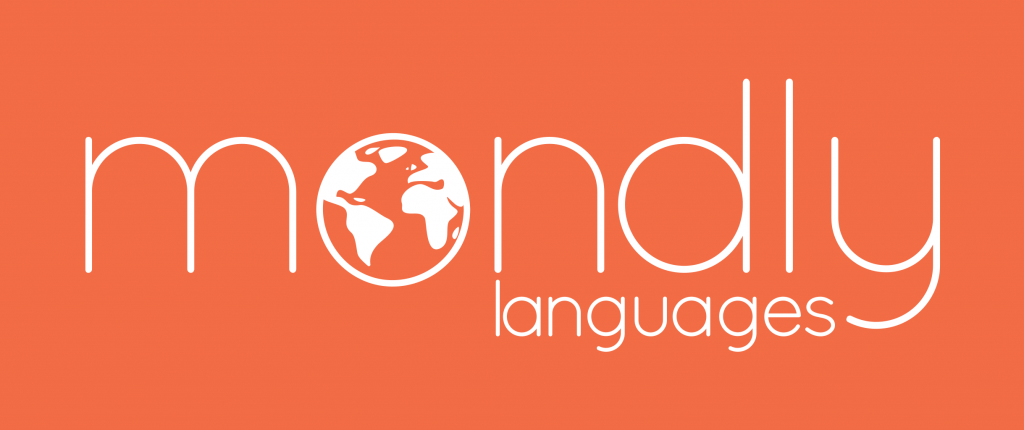XR creator Dominik Hackl: I developed Magic Keys to bring more joy to people
For his performance in the holocaust drama The Pianist, leading actor Adrien Brody won an Academy Award. A method actor, Adrien went to great lengths to portray his character, the Jewish Polish pianist who loses contact with his family during the Second World War and the struggles he faces to survive. To get into his character’s mindset, he lost 30 pounds in weight, sold his home and car, broke up with his girlfriend and practised the piano for four hours a day until he could master passages from compositions by Chopin.
Adrien Brody was 29 when he learned to play the piano. This goes to show that you can learn to play the piano at any age, even as an adult! It’s true that it’s too late to become a concert pianist, but if what you’re looking for is having fun playing music, there’s no better time than today.
If you’re reluctant to take up playing the piano because of the steep learning curve (you know: learning the notes, the music terms and so on), the Magic Keys app is the perfect solution.
Magic Keys is an extended reality app that helps you learn to play the piano in a new and easy way (you can learn the notes later).
The app was developed by Dominik Hackl, a passionate game developer with a strong interest in Virtual and Augmented Reality.

Magic Keys app creator Dominik Hackl
He’s also a pianist so he understands the needs of grown-ups who regret stopping piano lessons when they were kids or people who have never taken lessons but wished they had – like me.
For the people in either category, learning to play the piano is a dream come true (Check out the comments to his LinkedIn announcement).
In the interview below, Dominik answered a few questions on Magic Keys, the future of extended reality, what he would do if he were Mark Zuckerberg and the tech that makes his life easier as a creator.
Enjoy!
BRAND MINDS. We’ve seen VR applications in many industries: healthcare, education, and entertainment among the most prominent. Why did you choose piano learning?
DOMINIK HACKL. I am a passionate pianist myself and I’ve been playing the piano since the age of 8.
So when I first got into VR/AR development I immediately thought of this idea and knew that the piano and AR would be a perfect match.
Also, I know many people who would love to learn the piano but are afraid of the steep learning curve. With the app, my goal is to make the instrument more accessible and bring more people to enjoy it.
BM. What is the future of mixed reality applications in your opinion?
DH. There are many areas which can seriously benefit from Mixed Reality applications. But in my opinion, there is currently a little too much hype around the whole metaverse concept.
We should first focus on creating solid applications that can actually be achieved with the current state of hardware rather than already fantasizing too much about transforming all aspects of our lives into some kind of metaverse.
These discussions are definitely important but I think there is too little emphasis on what’s currently possible.
BM. You are the creator of a number of games for Windows and Android. Is game development experience mandatory for developing projects in Virtual and Augmented Reality?
DH. I would not say it is mandatory but there are certainly a lot of overlaps. Both, (3D) games and VR/AR applications are interactive 3D experiences, so topics like 3D math, shaders and rendering pipelines apply pretty much in the same way for these disciplines.
And of course, nowadays both will usually be built on one of the big game engines, Unity or Unreal.
BM. I would like to become a mixed reality creator, where should I begin?
DH. As mentioned above, most VR/AR apps are built on a general-purpose game engine: Unity and Unreal Engine are the major players. So, I would definitely start by learning one of the engines.
Unity would be my number one choice because it’s slightly more general-purpose and tends to have earlier support for new hardware while Unreal is more tailor-made for games. Then a good level of programming is also required since all engines rely on scripting to create the behaviours for your app.
For the major engines (and their scripting) there are plenty of tutorials and guides online, so YouTube is probably a good place to start.
BM. Here’s a short imagination exercise: you have replaced Mark Zuckerberg at the helm of Meta, what is your first project? Remember, your budget for special projects is at least ten billion dollars, the amount of money the company has invested in developing the Metaverse.
DH. First off, I’m really glad I don’t have to replace him in his position 🙂
But if so, I would probably put as many resources as possible into hardware development and research since this is currently the greatest bottleneck (kind of what they are actually doing, I guess).
I would also try to clean their image as an untrustworthy data mining company by advocating for open standards when it comes to the metaverse and future development in Extended Reality (XR).
BM. What’s one myth about VR, AR or mixed reality that we need to stop believing in?
DH. That it will completely replace physical reality within the next decades.
I am really optimistic about the use cases for XR and I can’t think of any reason why we would want to replace the great aspects of our reality with a virtual one.
There are many obvious benefits of XR but then there are also obvious benefits of physical presence. Just because something can be done from a technological point of view, doesn’t mean it makes sense to do it.
BM. What tool is making your life easy as a creator?
DH. The Quest’s Oculus Link feature is still one of the best things they have done. Plugging your Quest into your PC to effectively make it a PC VR headset works just so seamlessly and it especially is a huge time saver for developing and iterating.
BM. What book are you reading right now?
DH. “Blood, Sweat and Pixels” by Jason Schreier. It tells the behind-the-scenes development stories of several famous video games.
Reading it makes you appreciate even more what an incredible miracle – from a technical, creative and business perspective – it is that any of these games are being created and finished.
BM. What app do you use daily?
DH. YouTube is by far my most used app/website. I definitely use it daily for work and for entertainment.
In return, I am almost completely abstaining from other social media apps and I don’t spend much time on my smartphone in general.
Meta’s VR green garden, playing music & painting in VR and more from Lenovo and Snapchat
Meta’s green garden in VR
Meta is going further with its metaverse plan, investing billions of dollars (10 billion to be exact) into technology advancements, specifically hardware.
According to new reports, Meta is planning to release four virtual reality headsets by 2024. These headsets, sources say, have high-resolution image quality that’s clear enough for reading text so that you can type emails or code within the VR environment.
Building in the metaverse continues and here’s a sample of the kind of experiences Meta is preparing for us.
Intersectional environmentalist @Leahtommi and visual artist Vartika Jangid got together and imagined what a community garden could look like in the metaverse — and one thing’s for sure — going green is always in style. pic.twitter.com/XstJxuoE8y
— Meta (@Meta) May 5, 2022
Soft knitted robotic fingers from MIT CSAIL
Scientists from MIT’s Computer Science and Artificial Intelligence Laboratory (CSAIL) have designed a robotic wearable comprised of soft pneumatic actuators*. Motion is powered by compressed air and the actuators are knitted with conductive yarn for sensing, allowing the actuators to “feel” what they touch.
The wearable is a critical step forward in a variety of applications such as assistive wearables, robotics, and rehabilitative technologies.
Soft robotic banana fingers, brought to you via autonomous knitting: https://t.co/7iENSugX4G pic.twitter.com/cNhrBRnzNl
— MIT CSAIL (@MIT_CSAIL) May 4, 2022
*Actuator is a device fitted on a robot which causes parts of the robot to move: wheels turning, arms rotating, fingers gripping etc.
Google acquires AR Microdisplay Hardware startup Raxium
Raxium is a five-year-old startup pioneering pixel technology with record-setting innovation. According to the company, the MicroLed technology that they are developing enables a new class of smaller and more powerful display products, ranging from augmented and virtual reality micro-displays to life-size panel-based light field arrays. And what they are building is 5x more efficient than anything available right now on the market.
Google announced the acquisition on May 4, saying that “Raxium’s technical expertise in this area will play a key role as we continue to invest in our hardware efforts.” It looks like Google is growing into a strong competitor for Meta.
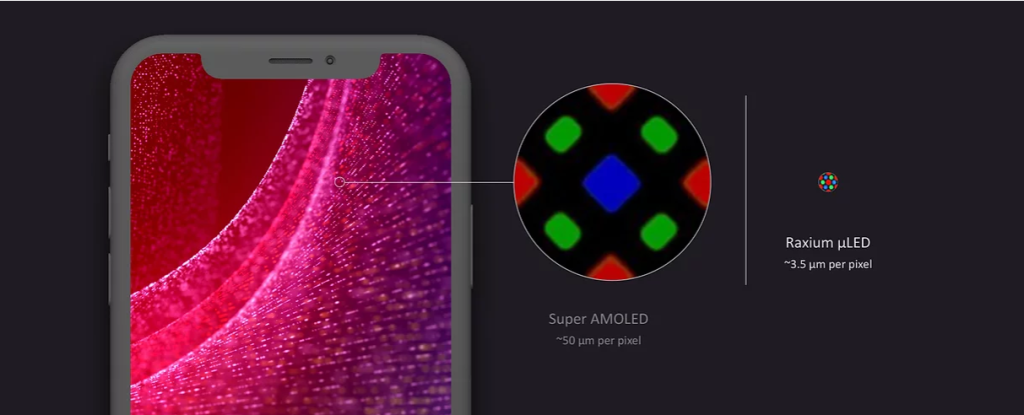
Image: Raxium.com
Snapchat is crafting stories in AR
Augmented Reality is not just for fantasy animals or engaging games. The social platform with the most advanced AR features is Snapchat. In 2019, the company announced it would invest $1 billion in AR content and developments. Recently Snapchat rolled out a series of AR features focused on enabling purchases in-app for brands and creators.
Another use for AR is storytelling. Snapchat partnered with The Los Angeles County Museum of Art to explore monuments and murals, representation, and history. In the clip below, you can see The River Once Ran, a Lens created by artist Judy Baca and Lens creator Holliday Horton.
Artist @judybaca and Lens Creator @HollidayHorton built The River Once Ran as part of @LACMA × @Snapchat: Monumental Perspectives Collection II. The Lens activates layers of history, recovering stories of diverse communities and exploring the consequences of taming the LA River. pic.twitter.com/L4Y8axmW8I
— Snap AR (@SnapAR) April 20, 2022
Lenovo won 3 Webby Awards for its innovative AR campaign, MLKonMLK
There are 955 streets that bear Martin Luther King Jr’s name and Lenovo transformed all of them into an immersive experience to celebrate black history. The company partnered with the DuSable Museum of African American History and created the MLKonMLK AR campaign, an immersive educational experience that brings Martin Luther King Jr.’s “I Have a Dream” speech to every single MLK street using augmented reality.
Congratulations, @Lenovo for winning 3 Webby Awards with the creative & innovative MLKonMLK #AR campaign! via @TheWebbyAwards https://t.co/tjS9hW8Nx6
How it was made: https://t.co/R8wjF9Gt9Y #AugmentedReality pic.twitter.com/pZ6Ix0AKlZ— BRAND MINDS (@brand_minds) May 3, 2022
Do you have a musical ear? Now you can play music in VR!
Making music is now easier with VirtuosoVR, the VR musical sandbox. Started in 2020 as a hobby project by Jonatan Crafoord, audio director on Angry Birds, LittleBigPlanet, and Minecraft, VirtuosoVR was released on Meta Quest, Rift and Steam VR in March 2022.
Which instrument in Virtuoso is your favorite and why?👀🤩🎶
Let us know in a comment below what’s your pick between Board, Oorgan, wHarp, Wavemin, Empads or Clustr!✨🥁🎹#vr #music #steamvr #quest2 #makingmusic #dj #virtuosovr pic.twitter.com/i96M8IP4ri
— VirtuosoVR (@VrVirtuoso) April 25, 2022
Discover your inner painter with Vermillion VR
We’ve seen VR use cases in entertainment, education, healthcare etc. Here’s another rather surprising use case for VR: painting, may it be as a hobby or for professional painters.
Vermillion is a VR oil-painting simulator created by Thomas van den Berge, a VR/AR developer. Vermillion started as an after-hours project during the first lockdown of 2020, where Thomas discovered the joy of painting through building a prototype.
Looking to upgrade your business and prepare for the future?
Attend BRAND MINDS 2022!
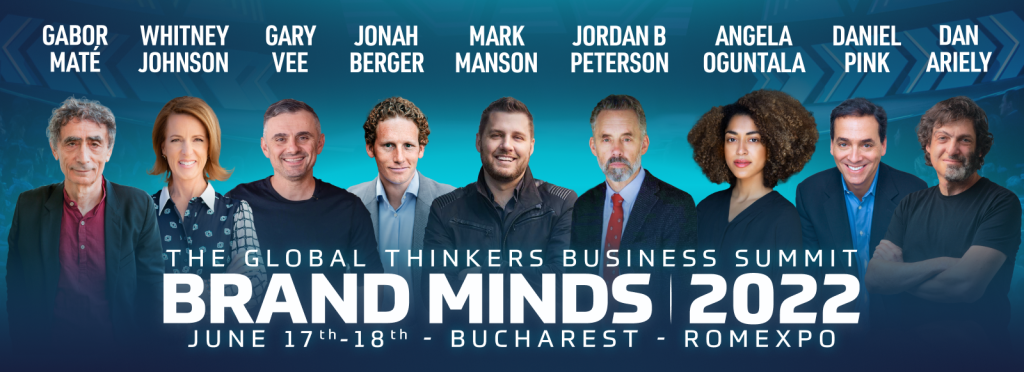
Learn A New Language With This Innovative App
Have you learned English or French in school from old worn out paper manuals?
Well, this old-fashioned way of learning languages is gone!
There’s a new and more exciting way introduced by this app: the Mondly Languages app.
What is the Mondly Languages app?
Mondly Languages is an app which combines solid neural science with cutting-edge technologies to help its users speak languages.
Mondly Languages uses AR and VR to offer its users immersive experiences. In this way, the user learns faster.
It also allows you to learn any of the 33 languages from your native language.
Mondly’s Mission
We founded Mondly to revolutionize the way people learn languages. We are passionate about using the latest technology in order to create the best and most effective language learning experience for our users.
Alexandru Iliescu, CEO of Mondly Languages
Mondly’s innovative features
- The first voice-enabled chatbot for language learning;
- The first Virtual Reality language app with speech recognition available for GearVR, Daydream and Cardboard;
- The first Augmented Reality experience in the world that uses speech recognition to help you learn languages;
- There are no computer-generated voices, all recordings in Mondly are made with native speakers.
Benefits of using Mondly Languages
- It’s fun, fast and easy;
- It offers immersive experiences;
- The app’s virtual teacher engages you in conversations, giving instant feedback on pronunciation;
- The Mondly chatbot brings language lessons to life.
Mondly in the media
INC.com – “The New Way to Learn Languages”
Bloomberg.com – “The closest thing to Classroom Education”
Forbes.com – “A practical approach to language learning likely to be widely adopted.”
Digital Trends – “The Mondly experience leverages the immersive quality of VR”
TheNextWeb.com – “The Closest Thing to Actual Immersion”
Huffington Post – “Virtual reality the new and sexier way to learn languages”
VentureBeat – “A lot more fun and easier than just reading flashcards”
Mondly by Numbers
- Founded in 2013 by brothers Iliescu, Alexandru and Tudor;
- 40 million downloads worldwide to date;
- Used by people in 190 countries;
- An average rating of 4.7 out of 5 from over 1M reviews;
- 33 languages.
Awards and Recognition
- Was chosen as “Editors’ Choice” by Google Play in late 2017;
- Won Facebook’s FbStart “App of the Year” in EMEA;
- Alexandru Iliescu, CEO of Mondly won Founder of The Year Award at the 2018 Central European Startup Awards.
Join the Conversation
We’d love to hear what you have to say.
Get in touch with us on Facebook Group and Twitter.
Virtual Reality and Airbnb make it more real and fun
Airbnb is developing virtual and augmented reality features to help guests find and navigate rental listings, the company announced recently on its blog. Three-dimensional scans and 360-degree photos would allow users to get a better sense of a listing, and augmented reality overlays could help guests better understand the homes on a smaller scale once they’re in it. The company has been looking into VR to build trust between guests and hosts since last year, and this announcement confirming experiments and prototypes could mean a feature is coming soon.
“Mobile technology took this a step further, allowing people to be more adventurous when they arrive. Rather than being locked into a rigid tourist flow, travelers can get lost (and found, thanks to GPS-based map apps), explore, and enjoy the serendipity of last-minute decisions. Today, when traveling, people can live like locals in a downtown apartment in the arts district, eat at local cafes and take classes from homegrown artists—today’s travel is experiential travel. As mobile technology progresses, immersive technologies like virtual reality and augmented reality are giving us new and powerful tools to reduce the barriers to travel and the inherent friction that comes with it,” said the Airbnb press release.
Therefore, Virtual reality gives Airbnb an opportunity to reshape where inspiration is drawn from, and take travel planning to the next level. It can also allow people to connect with their destination, host, and co-travelers. Capabilities like 360 photos and 3D scans allow a person to step inside a home or city and understand what to expect and how to orient themselves before they leave the comfort of their own home.
“With augmented reality, we’re looking at ways to make travel more seamless, reducing obstacles to having a transformative experience. The more immersed a traveler is in a new place, the more they’ll learn about the people and culture. While this is often delightful and transformative, it can also be stressful when someone doesn’t know how to unlock the door or turn on the hot water for a shower, or when they’re hopelessly lost and everything is in a foreign language,” adds Airbnb on the blog.
Biggest digital trends in 2018
For the last five years, the agency Ogilvy creates an annual report which aims to spot the key trends in digital and social media marketing that are likely to be important in the coming year. The report contains the agency’s predictions from the previous year and every trend includes actual, actionable recommendations for brands. In 2018, for its fifth report, Ogilvy included also a section that reflects on five years of trends, and looks at the big stories the agency’s representatives have seen play out since they started writing the report.
The report can be seen here and it features five big trends to watch for in 2018: Augmented Reality, The End of Typing, The Tragedy of the Commons in Influencer Marketing,The Amazon Awakening and Seriously Serious.
In our turn, we’ve talked with two specialists on the Romanian digital industry and we found out their predictions and thoughts.

Flavian Cristea, Digital Strategist Grapefruit:
– What do you believe will be the biggest digital trends of 2018?
The biggest digital benefits for customers will come from conversational interfaces and specialized artificial intelligence. These technologies enable customers to use natural language to interact with companies and their assets. We will be seeing more and more cases of making a bank deposit by messaging a chatbot or ordering products from the internet by using digital assistants such as Google Home or Alexa.
We are seeing specialized artificial intelligence and mixed reality as being the main drivers of digital change inside companies. These technologies are used to strengthen the capabilities of the employees, getting more out of the same individuals. It’s a complementary relationship, where the technological aspects fill in for the weaknesses of the humans and the other way around. Blockchain is also a technology that migrated from cryptocurrency to other businesses such as banking and trading, opening new ways of communicating, controlling and tracking information.
– What are they influenced by and why?
The user wants the barrier between the digital and reality to disappear. This desire appears out of the wish of the individuals to interact in a more natural way with everything they use. It’s easier to ask “How much money do I have in my account?” than to go inside a banking application and check your account. It’s also more natural to interact with objects with your hands than with your mouse.
Another obvious influencer is the progress we have achieved in the fields of artificial intelligence and virtual reality. The fact that these technologies are also researched and developed in an open way is a great contribution because everybody can experiment and share what they learned in the process.
– What is Grapefruit advising its clients this year?
We advise our customers to find contexts inside their company to experiment with each technology mentioned above. It does not have to be a big project. Just big enough that, if successful, it can become a pilot project for a bigger digital change.

Andrei Balan, Head of Strategy MRM McCann
– What do you believe will be the biggest digital trends of 2018?
Two things I’d look for in the following year are the access and sharing economy spreading to different aspects of our lives and micro targeted content.
– What are they influenced by and why?
Let’s start with the access and sharing economy. The basic idea here is the digital environment contributes to a steep increase in the number and intensity of desires. The overall digital connectedness lets us know about products and services virtually instantaneously. It also provides us with unprecedented insight into other people’s curated live, so we get to know what everyone has and does. These are both vectors for wanting more things more intensely. Moreover, things like retargeting contribute to turning these desires into quasi-obsessions. But what happens when the number and intensity of desires increases much faster than the financial means to support them? It builds up to phenomena such as the access economy, the sharing economy and then the democratization of all sorts of things and services. For example, why own music when you can just rent and listen to it? Also, people now get to travel to more distant places because Airbnb allows them to cut accommodation costs and invest more in transport. This is a simple example of touristic democratization enabled by the sharing economy.
Now let’s talk about micro targeted content. As it is becoming clearer content is winning the battle with online advertising, we’re starting to look more into what, how and why it works. Using real people, famous or not, to provide credibility to content is already something everybody does. The next base is micro targeting, or micro community-tailored content. This means building certain variations into a marketing campaign that make it more relevant for each segment of the public. And then using media targeting to reach each community with the proper variation.
– What is MRM advising its clients this year?
Our advice? Have no fear in riding the trends. I know countless people who regret not investing early in cryptocurrencies. I myself am one of them. The same thing goes with all trends: ride them early enough to be among the ones who profit most.
All you need to know about Facebook 360 Live
With Facebook 360, publishers can showcase their most compelling stories in a new and immersive way, bringing the viewer inside a different world through 360 photos and videos.
To create 360 videos, a special set of cameras is used to record all 360 degrees of a scene simultaneously. This means that when the video is playing on Facebook, viewers can choose what angle they want to see it from. On the web, this is done by dragging around the video with your cursor. On mobile devices, viewers can drag with their finger — or even just turn their device.
360 video is currently viewable on the web and on Android and iOS devices.
When people discover a 360 video in News Feed, a new gyroscope animation tells them that the content is different. This animation is shown while the video is loading, and is replaced by the heading indicator when the video is ready to explore. If a views doesn’t tap the video or move their device within four seconds a helper animation prompts them to move their phone and explore the scene. This improved UI lets publishers concentrate on creating compelling videos without needing to add instructional text.
In addition, Facebook added a heading indicator that shows the viewer the current direction of view relative to the video’s initial orientation, as well as the current zoom level. If Guide is enabled, the heading indicator will show the viewer whether they’re in an automated guided view, or exploring freely. If they opt out of Guide, viewers can simply press the heading indicator to resume the automated view.
According to The Verge, one can now view live-streamed 360-degree video on Facebook in up to 4K resolution, helping increase the fidelity of streams for viewers who have a capable monitor and creators who have powerful enough streaming gear. “Those streams are also now accessible in virtual reality, if you’d rather watch the 4K video on a Samsung Gear VR. (Facebook says 4K / 360-degree live video isn’t supported on the Oculus Rift at the moment.) For nonprofits or pages that want to support nonprofits, Facebook now lets you add a “donate” button to raise money from viewers,” wrote Nick Statt for The Verge.
5 domains that will be revolutionised by VR – part II
This is a continuation of last week’s article.
3. Healthcare and medicine
According to inc.com, one of the key implementations of virtual reality in the medical field is that it will allow doctors and medical professionals to practice procedures that they don’t regularly have access to in the office. There are a variety of different mobile virtual reality devices that are becoming equip to handle these exercises. Among them, Gear VR, VR One, and Google Cardboard have stood out as some of the most promising. These devices will dramatically change the way in which hospitals and health care facilities are able to train their nurses, doctors, and medical personnel. There are many instances of virtual reality already playing a role in training.
Nicklaus Children’s Hospital has recently partnered with Next Galaxy Corp, an augmented and virtual reality company, to create software designed for procedures in hospitals. The technology is centered on the virtual reality medical instructional software, which functions to guide users through procedures like a Foley catheter insertion, cardiopulmonary resuscitation, and wound care. As the technology continues to advance, training new employees will become easier and more cost effective. In addition, the training itself will be more effective. “By enabling the trainee to immerse himself in a virtual reality environment, the staff member is able to synthetize a much more realistic and memorable experience for the new employee. Among its many proven benefits, virtual reality has shown remarkable abilities in enabling medical staff to learn and retain information,” writes inc.com.
For the first time in the history of medicine, on 14 April 2016 Shafi Ahmed cancer surgeon performed an operation using a virtual reality camera at the Royal London hospital. Everyone could participate in the operation in real time through the Medical Realities website and the VR in OR app. “Virtual reality could elevate the teaching and learning experience in medicine to a whole new level. Today, only a few students can peek over the shoulder of the surgeon during an operation and it is challenging to learn the tricks of the trade like that. With a virtual reality camera, surgeons can stream operations globally and allow medical students to actually be there in the OR using their VR goggles,” writes medicalfuturist.com.
At the same time, VR can help relax the patients, treat their phobias and PTSD. Professor Albert Rizzo, director of VR in the medical field and who works at the Institute of modern creative technology, uses virtual reality exposure therapy, particularly with the soldiers, who survived post-traumatic stress syndrome, caused by hostilities. The essence of the therapy lies in patient’s immersion in simulation, where he drives the Hammer and suddenly a homemade device explodes in a certain place. “This is peculiar stimulation of the imagination, where the patient is trying to work over the trauma or any other problems by a specific provocative method,” wrote Forbes.
More you can read here, here and here.
4. Tourism
The tourism industry is one of the first to take advantage of the technology. Many tourism sites has developed VR tours, which take you to a world where you feel that you are part of the scene and can have interactions with the various elements at the scene. Most of the world famous sites have some or the other technologies in action to help increase the visitor experience.
According to Lonely Planet, Marriott Hotels has been trying out virtual reality experiences and has allowed guests at certain hotel locations to trial a VR headset. The company also unveiled a virtual travel content platform – called VR Postcards – which are immersive travel stories that follow a real traveller heading to a unique destination, such as the Andes Mountains in Chile, an ice cream shop in Rwanda or the streets of Beijing. “Some companies are using VR to entice would-be travelers to their product. Earlier this year, Carnival Cruises ran a promotion with AT&T using Samsung VR technology. They set up in 133 stores around America allowing people to have a virtual reality experience of what it’s like aboard one of their cruise ships. The company noted that it’s exploring how it could adopt VR into its sales as it could be used by travel agents to show to clients a prospective cruise experience,” explains Lonely Planet.
Moreover, a recent Travelzoo survey of more than 6,000 travellersin Asia, Europe, North America and South America found about 80% of people feel robots will be a big part of their lives by 2020 and nearly two-thirds said they would be comfortable with using them in the travel industry. Those efforts are already underway in certain places, as Amsterdam’s Schiphol Airport and KLM have been testing a robot designed to help passengers find their gates and Costa Cruises have a new multi-lingual humanoid robot that can give recommendations to travelers.
5. Entertainment
Offering a distinctive experience far beyond attending a concert, show or sports game, virtual reality technology provides a standout option to live entertainment enthusiasts everywhere.
Moreover, with virtual reality technology, more fans can have that front row experience. The specialized 3-D 360-degree technology offers a view that being in the audience could never buy – placing cameras in locations beyond a front row experience (i.e. under the basketball hoop, in the end zone, etc.) – and gives the user the feeling of being in a special place. “Virtual reality provides a whole new medium. Whereas Hollywood movies have to be 72 minutes to be considered a theatrical film, virtual reality doesn’t have these restrictions. In fact, viewers have the opportunity to do so much more, such as meeting the actors and actresses “in-person” – an opportunity that few others have had the chance to do,” says psfk.com.
Another interesting perspective can be read here.
5 domains that will be revolutionised by VR – part I
The virtual reality is here and ready to help not only entertain, but educate and influence profoundly our lives, for the better. Here are 5 domains that already see a big influence and that will see even more in the future.
- The real estate industry
Virtual reality can be a great asset when it comes to the real estate. From buying a house, 360 views and being a help for the real estate officers, VR can come in handy and prove to be really helpful. When it comes to open houses, a majority of the real estate domain is moving, well, to domains. The entire estate agent process can be performed online on sites like eMoov and CastleSmart, with virtual reality added in, buying a house is about to become a whole lot more lazy.
When a client is interested in buying a specific property the estate agent will usually arrange a viewing of said property or, in more lavish cases, host an open house. These events allow the potential buyers to walk through the home and examine the property. Now, imagine the prospective shopper was able to view the property from the comfort of their own home. Likely it would result in a greater interest for that residence which would create a faster sale. With VR this is very possible. Clients could put on their headsets and could be electronically strolling through the property within seconds. This means a lot of time and resources that are speared.
Moreover, the virtual reality can help so that the entire inspection could take place from the workplace of the agent. Several images and videos of the property would need to be taken to ready the virtual home for inspect. The same procedure would need to take place if a valuation was to be made via VR.
Also, most trainee estate agents learn the ropes by shadowing one of their senior colleagues on the job, following them around on viewings, visits and valuations, etc. Virtual training methods could be created which pits the user in situations that they would face on the job, such as getting questions from potential buyers, explaining features in a property. This could save real estate firms thousands in training expenses.
2. Education
According to the Smithsonian Mag, the students in classrooms across the United States and parts of Europe will soon be able to go on field trips to Buckingham Palace, Machu Picchu and the Great Barrier Reef, but they’ll be doing it through virtual reality. Google recently announced that it is expanding its Expeditions Pioneer Program, which brings virtual reality field trips to classrooms using Google’s cheap, smart phone-based VR viewer, Cardboard. The goal is to expose students to places they wouldn’t be able to see otherwise.
The idea for Expeditions came from a hackathon in Google’s education department. Given 36 hours to create a tool that would boost student engagement, Jen Holland, then a product manager at Google Apps for Education, drew on existing Google assets—the recently launched Cardboard, some teaching apps in development and a huge archive of 3D maps and photographs. She combined the three to make interactive virtual reality lessons, which she calls “experiences.”
Students can use Cardboard—an inexpensive pair of VR goggles made from a cardboard cutout, magnets, an Android phone and an app—to move through an experience that their teacher controls from a tablet. The Expeditions program has distributed the equipment to classrooms and worked with teachers to figure out lesson plans, but now, Holland says, they’re opening it up, so any teacher with a tablet and access to VR viewers (Cardboard costs about $20) can use it. With lessons loaded on the tablets, teachers and students don’t need to have internet access, which is important for low-resource classrooms.
Once students put on the VR headsets, they’re immersed in a 3D version of Machu Picchu or the Smithsonian’s National Museum of Natural History. They can look around, and the teacher can share information about things they’re seeing. Google built a Great Wall of China experience for a fifth grade math class, to give the students a more tactile lesson about multiplication. The same experience has been the topic of conversation in a 10th grade Chinese language class, and it provided physical context for students in a 12th grade history class and an anthropology lecture at a Brazilian university.
More you can read here.
What medical technology brings new in 2017
- CRISPR
According to CBS, at the International Summit on Human Gene Editing, hosted by the U.S. National Academy of Sciences in Washington, the Chinese Academy of Sciences and the UK’s Royal Society, much discussion surrounded a newly developed gene editing biotechnology called CRISPR — derived from a bacterial protein — that lets scientists clip away or tweak specific portions of DNA. “It has the potential to help get rid of certain diseases by splicing out defective snippets of our genes. But because of the unknown long-term impact, some leading scientists are calling for a moratorium on its use,” says CBS.
2. Wideband medical radar
Painful mammograms requiring the patient to stand while her breast is compressed in an X-ray machine might soon be a thing of the past. Current mammography techniques are not only painful but expensive, and may expose the patient and clinicians to harmful ionizing radiation. But medical radar is now being developed for imaging breast cancers, using radio waves instead of sound or radiation. Medical radar uses electromagnetics similar to a microwave oven or cell phone, but at extremely low power. It is also a fast and easy-to-use technology. The process takes less than a minute, and both breasts can be scanned while the patient lies comfortably on a table.
3. 3D bioprinting of human tissue
The process is based on liquefying cells from either the patient or a donor in order to provide oxygen and nutrients. The cells are then deposited on a scaffold, layer by layer, based on a predetermined configuration customized to the patient. Then the bioprinted structure is incubated until it becomes viable tissue. Several universities have created their own bioprinters, and manufacturers such as the Swiss-based regenHU Ltd. and German Envision TEC are selling 3D bioprinting equipment and materials.
California-based Organovo and other companies are currently providing functional human tissue for pharmaceutical testing, and in December 2016 Organovo presented the first data showing survival and sustained functionality of its 3D bioprinted human liver tissue when implanted into animal models. Organovo aims to submit such therapeutic liver tissue to the FDA in as soon as three years. Moreover, Russian 3D Bioprinting Solutions printed a functioning thyroid in a mouse model and claims to be ready to do the same in humans.
4. Smart acupuncture
It might be one of the oldest forms of healing, but acupuncture has some innovations on the way. According to Forbes, Kiseok Song, a student at the Korea Advanced Institute of Science and Technology, has created a way to deliver “ smart acupuncture”—a version of the ancient practice that uses electro-acupuncture to provide data on treatment. While the technology is still in development, this could potentially transcend multiple fields of study as a way of healing.
5. Electromagnetic acoustic imaging (EMAI)
This is an emerging imaging technology that combines bio-electromagnetism with acoustics. The result is an ultrasound device that’s safer than a CT and can provide images that approach MRI quality. It offers physicians the ability to distinguish between malignant and benign lesions at a fraction of the cost of higher-end systems such as MRI or PET.
The science is based on dissimilar tissues reacting differently to outside stimuli. Each layer of tissue will vibrate at its own unique frequency when stimulated. This can be measured and converted into an image by means of ultrasound detectors. Researchers have used light, ultrasound, and electromagnetic energy for stimulating tissue.
Cancerous tissue is 50 times more electrically conductive than normal tissue, and electromagnetic energy also has the ability to penetrate much more deeply into the body than light. This makes electromagnetic acoustic imaging an excellent technology for diagnosing a whole range of tumors despite their location. Studies have shown that the low levels of electromagnetic energy required for the body are safe, and can detect tumors as small as two millimeters in diameter. Not only is EMAI effective, less expensive, and safe, it’s fast and the equipment is portable.
6. The Microsoft Kinect-powered physical therapy
With the physical therapy industry being estimated at USD 30 billion, it has been changing rapidly, also with the help of Virtual Reality and motion-sensor technology, ready to improve the process. For example, in 2015, the FDA approved Reflexion Health to introduce an at-home rehabilitation program using Microsoft’s Kinect. Vera is a digital medicine software system that uses the Kinect technology in helping patients with musculoskeletal rehabilitation. When used, patients will see an avatar on their television screen that will coach and motivate them to perform the exercises at home. The sensor will track their progress and report the data back to the patient’s physical therapist who is also monitoring their activity in real-time.
7. Headspace helping meditation
According to the National Center for Complementary Integrative Health, meditation can have a profound impact on both your mental and physical health. It’s becoming apparent that this is a great alternative to taking medication, and is something you should certainly consider if you experience anxiety. Though technology and meditation may not seem like a likely pairing, apps like Headspace can help you maintain your mental focus while on the go.
8. Nanobots treating strokes
Stroke is the No. 5 killer in the United States. Even when the patient survives the result can be long-term disability, which can be heartbreakingly painful and very expensive. Nanotherapeutics, treating disease on the molecular level, is already being used in the treatment of cancer and infections. Now emerging targets of nanobots are breaking up stroke-causing blood clots and the precision delivery of drugs for reversing the effects of stroke.
Scientists have been studying platelet-sized nanobots coated with a tissue plasminogen activator (tPA), one of the most effective clot-busting drugs known. These nanobots are fabricated as aggregates of multiple smaller nanoparticles (NPs). The microscale aggregates remain intact when flowing in blood under normal conditions, but break up into individual nanoscale components when exposed to the blocked artery.
9. The Echopixel – A revolution in 3D medical imaging
EchoPixel renders patient-specific anatomy in an intuitive, interactive virtual reality format, leading directly to increased clinical knowledge, faster operations, and better care. True 3D, from EchoPixel, is an advanced medical visualization software solution. It offers physicians an unprecedented opportunity to view and interact with patient tissues and organs in a truly 3D form, as if they were real physical objects.
It takes data from CT and MRI scans and transforms it into 3-D holographic images so she can view and interact with patient tissues and organs as if they were real physical objects. Medical 3-D imaging is not new, but the way organs appear to pop out of the screen and the ease at which the anatomy can be manipulated has never been seen before in medicine.
10. Human head transplants
Sergio Canavero , an Italian neurosurgeon, intends to attempt the first human head transplant, though no successful animal transplants with long-term survival have yet been made. Because of the difficulty of connecting the spinal cord, Canavero has suggested improvements in the process using a special blade and polyethylene glycol, a polymer used in medicine as well as in everything from skin cream to the conservation of the Mary Rose, can help start growth in spinal cord nerves.
A special bio-compatible glue will hold the spinal cord together so it can fuse with the donor body. The patient will then be put in a drug-induced coma for four weeks while the connection between the head and body heals. Canavero says all the technology he needs is available, and estimates the procedure will take about 36 hours and require the services of 150 medical professionals. He expects a 90% chance of success, as in a 90% chance the patient is up and walking around a few months after the surgery. This all still sounds like science fiction, and medical professionals are mostly skeptical of Canavero’s plan.
Worldwide technology trends in 2017
The technology is advancing nowadays even faster than the speed of light. Its advances and upgrades can seem overwhelming, thankfully though we have the specialists to help us understand where we are heading and how to handle it. The Deloitte’s 2017 report outlines how companies presently must sift through the promotional noise and hyperbole surrounding emerging technologies to find those solutions offering real potential. To realize that potential, they should become ‘kinetic’ organizations—companies with the dexterity and vision required to thrive amid ongoing technology-fueled disruption.
While the report identifies key trends that will likely revolutionize enterprise technology in the next 18-24 months, the exponentials chapter looks even farther into the future, describing four key areas that blend science and applied technologies.
The 2017 trends identified by Deloitte, digitaltrends.com, Forbes and Gartner are as follows:
IT unbounded—The boundaries surrounding IT are fading as technology becomes integral to almost every business function and relationship.
IoT and Smart Home Tech
A multitude of wireless technologies now exist to serve your smart home needs — Zigbee, Z-Wave, Bluetooth, Wi-Fi, and more. And there’s more smart home platforms to consider than ever before too — Wink, SmartThings, Iris by Lowe’s, even systems from security providers like ADT and big brands like Comcast. While centralization in theory should make things easier, it’s made it worse.
The AI world will have a head-on collision with the Internet of Things in 2017, too, Gartner predicts. IoT is where everyday items get chips or sensors, and apps, and join the internet — from your car to your toothbrush. It makes total sense that the apps that control IoT devices will also make use of machine learning.
In 2017, watch for devices to start to communicate and help each other make decisions. “As intelligent things, such as drones, autonomous vehicles and smart appliances, permeate the environment, Gartner anticipates a shift from stand-alone intelligent things to a collaborative intelligent things model,” Gartner says. Gartner estimates that six billion connected “things” will be actively requesting support from AI platforms by 2018.
The total IoT market is estimated to grow from $157.05 billion in 2016 to $661.74 billion by 2021, predicts Markets and Markets.
Artificial Intelligence and Automation

AI and chatbots that understand context a whole lot better than ever before. More and more jobs will also be automated, we’ll also see smart devices gain from increased automation, learning your patterns and preferences without you needing to tell them and making better and more accurate suggestions and recommendations.
Research firm Markets and Markets estimates that the AI market will grow from $420 million in 2014 to $5.05 billion by 2020.
Artificial Reality and Virtual Reality
According to Gartner, virtual reality (VR) and augmented reality (AR) transform the way individuals interact with each other and with software systems creating an immersive environment. For example, VR can be used for training scenarios and remote experiences. AR, which enables a blending of the real and virtual worlds, means businesses can overlay graphics onto real-world objects, such as hidden wires on the image of a wall. Immersive experiences with AR and VR are reaching tipping points in terms of price and capability but will not replace other interface models. Over time AR and VR expand beyond visual immersion to include all human senses. Enterprises should look for targeted applications of VR and AR through 2020.
As forbes.com points out we’ve already seen some major steps forward for augmented reality (AR) and virtual reality (VR) technology in 2016. Oculus Rift was released, to positive reception, and thousands of VR apps and games followed. We also saw Pokémon Go, an AR game, explode with over 100 million downloads. The market is ready for AR and VR, and we’ve already got some early-stage devices and tech for these applications, but 2017 it’s going to be the year we see things really take off. Once they do, you’ll need to be ready for AR and VR versions of practically everything—and ample marketing opportunities to follow.
“Look for navigation services to get even more specific — maps in a store’s app, for example, to direct you to a specific aisle to find exactly what you’re looking for. So called “augmented reality,” where virtual objects and information are displayed on top of the physical world, will make its way to our phones. Search engines are already expanding on image search, allowing you to point your camera at something and search for information based on what the lens takes in,” said Ed Oswald for digitaltrends.com.
IDC predicts that worldwide revenues for the augmented reality and virtual reality (AR/VR) market will grow from $5.2 billion in 2016 to more than $162 billion in 2020.
Advances in computer vision and pattern recognition allow companies to unlock insights from unstructured data that until now, have been lost in the dark.
Machine intelligence is helping companies make better decisions, embed complex analytics into customer and employee interactions, and—with adoption of bots and robotic process automation—automate increasingly difficult tasks.
“Throughout 2017, I expect to see machine learning updates emerge across the board, entering almost any type of consumer application you can think of, from offering better recommended products based on prior purchase history to gradually improving the user experience of an analytics app. It won’t be long before machine learning becomes a kind of “new normal,” with people expecting this type of artificial intelligence as a component of every form of technology,” predicts Jayson DeMers for Forbes.
Mixed reality (Physical-Digital Integrations)
Companies are exploring more immersive and engaging ways to combine the physical world and digital systems, creating a new, mixed reality that’s more natural, intuitive and intelligent.
Mobile devices have been slowly adding technology into our daily lives. It’s rare to see anyone without a smartphone at any given time, giving us access to practically infinite information in the real-world. We already have things like site-to-store purchasing, enabling online customers to buy and pick up products in a physical retail location, but the next level will be even further integrations between physical and digital realities. Online brands like Amazon will start having more physical products, like Dash Buttons, and physical brands like Walmart will start having more digital features, like store maps and product trials.
Open standards, cloud-first designs and loosely coupled architectures are the norm in start-ups. Now, large enterprises have similar ambitions.
Traditional business products are being reimagined as services as organizations modernize core systems and the technology stack.
Digital Twin
According to Gartner, within three to five years, billions of things will be represented by digital twins, a dynamic software model of a physical thing or system. Using physics data on how the components of a thing operate and respond to the environment as well as data provided by sensors in the physical world, a digital twin can be used to analyze and simulate real world conditions, responds to changes, improve operations and add value. Digital twins function as proxies for the combination of skilled individuals (e.g., technicians) and traditional monitoring devices and controls (e.g., pressure gauges). Their proliferation will require a cultural change, as those who understand the maintenance of real-world things collaborate with data scientists and IT professionals. Digital twins of physical assets combined with digital representations of facilities and environments as well as people, businesses and processes will enable an increasingly detailed digital representation of the real world for simulation, analysis and control.
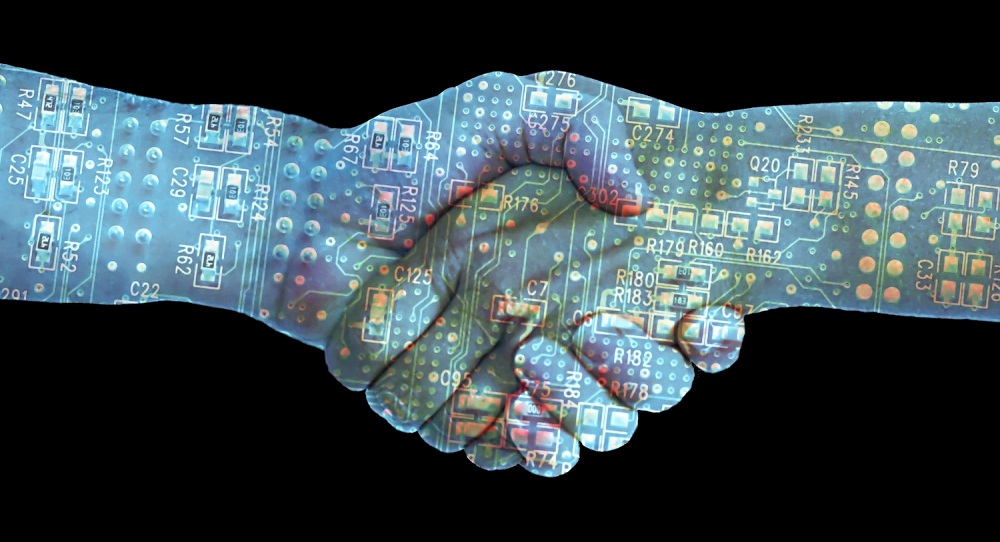
source: Blockchain Technologies
Blockchain, a way of distributing a database across many far-flung computers, is emerging as the mainstay for digital identities in the emerging trust economy.
Exponentials watch list – Advances in disruption forces like synthetic biology, energy storage, quantum computing, and nanotech could exponentially transform the way we do business. Remember the big Bitcoin phenom of 2015? It turns out that the coins themselves could be far less valuable than the underlying technology, called blockchain, that created them.
Consortiums have sprouted up to create new blockchain apps for the financial industry, for health care, and so on.
Market Reports Hub believes the global blockchain technology market will grow from $210.2 million in 2016 to $2.3 billion by 2021.
Advances in disruption forces like synthetic biology, energy storage, quantum computing, and nanotech could exponentially transform the way we do business.
Humanized Big Data (visual, empathetic, qualitative)
Big data has been a big topic for the past five years or so, when it started making headlines as a buzzword. According to Forbes, the idea is that mass quantities of gathered data—which we now have access to—can help us in everything from planning better medical treatments to executing better marketing campaigns. But big data’s greatest strength—its quantitative, numerical foundation—is also a weakness. In 2017, I expect we’ll see advancements to humanize big data, seeking more empathetic and qualitative bits of data and projecting it in a more visualized, accessible way.
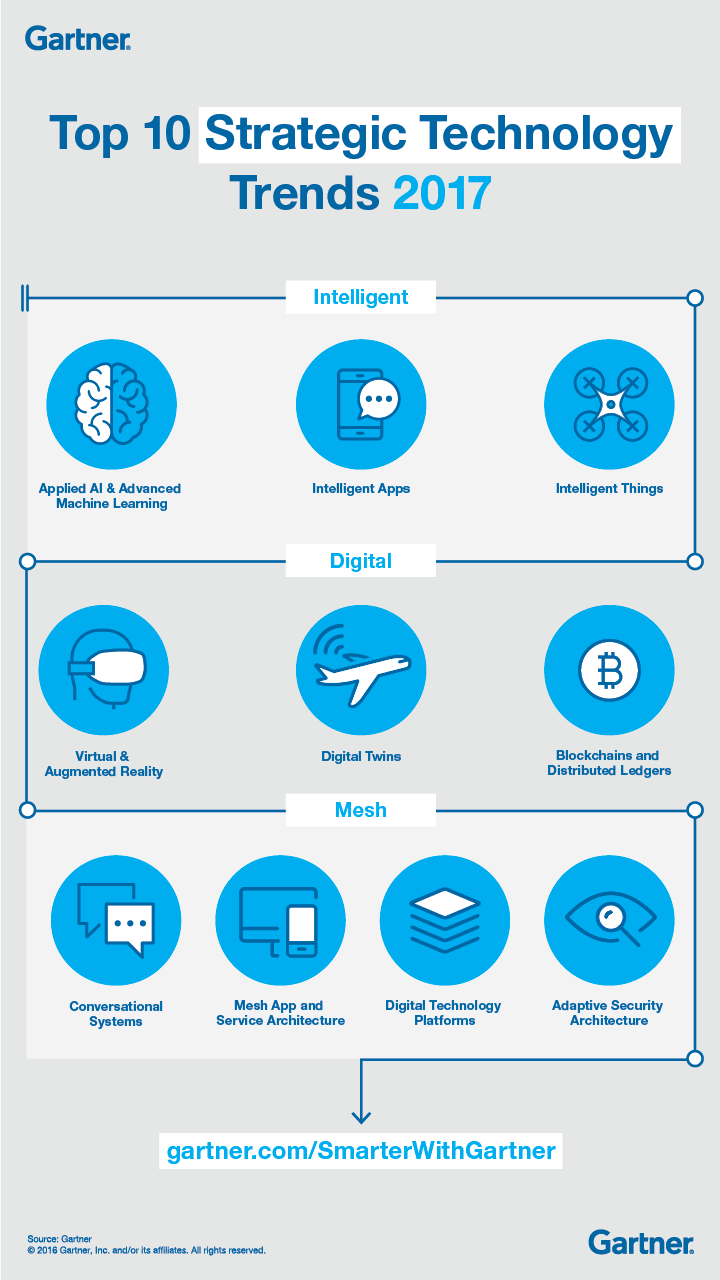
Adaptive Security Architecture
“The evolution of the intelligent digital mesh and digital technology platforms and application architectures means that security has to become fluid and adaptive. Security in the IoT environment is particularly challenging. Security teams need to work with application, solution and enterprise architects to consider security early in the design of applications or IoT solutions. Multilayered security and use of user and entity behavior analytics will become a requirement for virtually every enterprise,” points out Gartner.



